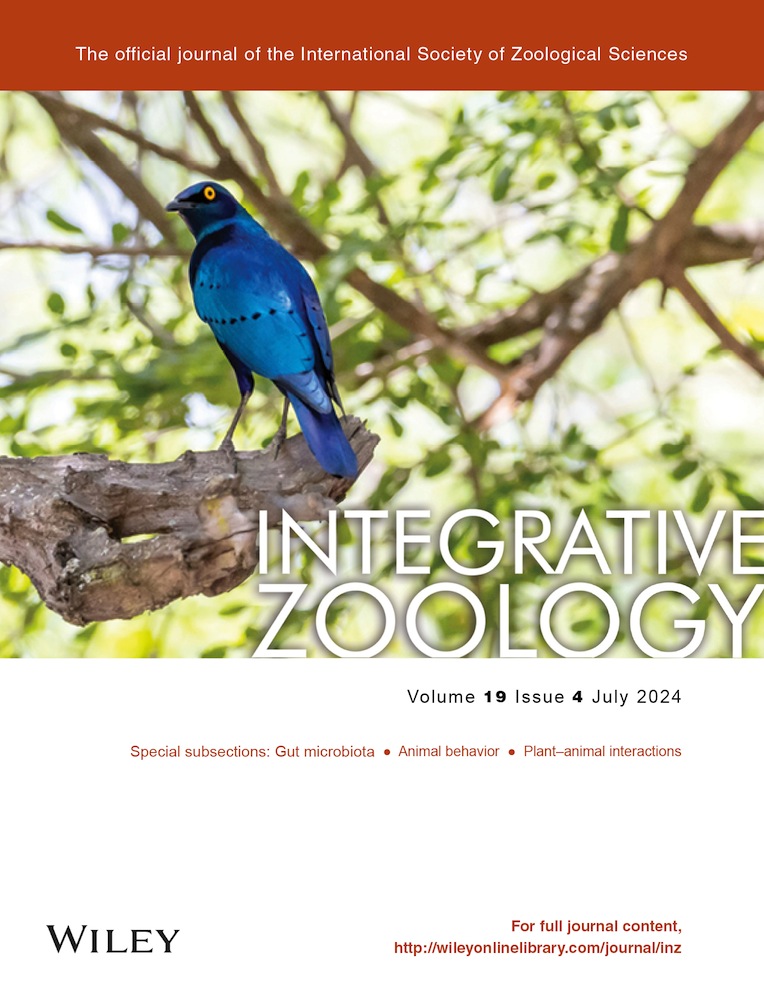Quercetin promotes the secretion of musk by regulating the hormone level and microbial structure of forest musk deer
Abstract
Musk is a scarce and precious medical resource secreted by male forest musk deer (FMD). Current research to promote musk secretion in FMD has used almost exclusively hormone injections, but this approach can be detrimental to the health of FMD. In order to conserve this endangered species as much as possible while increasing the production of musk, this study first used bioinformatics methods to predict the function of quercetin, a flavonoid that promotes testosterone (T) production and prevents late-onset male hypogonadism. On the basis of good prediction effect, different concentrations of quercetin were added to the diet of FMD. The results showed that quercetin could change the levels of T, luteinizing hormone releasing hormone, luteinizing hormone, and estradiol, and regulate the structure of intestinal microorganisms and musk microorganisms of FMD. Moreover, there is a correlation among musk components, hormones, intestinal microorganisms, and musk microorganisms, which indicates that the production of musk may be regulated by these three at the same time, and the addition of quercetin with 800 mg per kg diet could significantly increase the yield of muscone (P < 0.05), the most effective ingredient in musk. In addition, quercetin decreased the high level of cortisol during musk secretion, which may relieve the stress on FMD in this process. This may help to protect the health of FMD. Combined with the results of software prediction, we finally proposed a possible mechanism for the complex process of musk secretion in FMD with a view to providing ideas for further studies.
INTRODUCTION
Forest musk deer (Moschus berezovskii, FMD) is an Artiodactyla mammal with high medicinal value and important ecological as well as scientific research value, and it is a medicinal animal that produces musk, an important medical resource in China. In their males, there is a musk gland that secretes musk between the navel and genitalia (He et al. 2014; Yang et al. 2021). Musk is a valuable resource in Asian traditional medicine and international perfume industry (Yang et al. 2003). As a medicine, musk is considered to have anti-inflammatory and antitumor properties, as well as significant effects on the central nervous system and cardiovascular system (Fan et al. 2017; Abd et al. 2018). However, the FMD population is far from enough to meet the large demand for musk (Wang & Ha 2018). At present, FMD is listed in the appendices of IUCN (International Union for Conservation of Nature) Red List of Threatened Species and CITES (Convention on International Trade in Endangered species of Wild Fauna and Flora) (Qi et al. 2011). Therefore, there is an urgent need to strengthen the understanding of the secretion mechanism of musk and to find ways to increase the yield of musk.
The level of sex hormones in FMD has been reported as an important factor affecting the production of musk. Injection of exogenous testosterone (T) can promote musk secretion of FMD in non-secretory season, and even restore musk secretion of elderly FMD that have lost this ability (Su & Wei 1991; Jie et al. 2014; Fan et al. 2018). In addition, injection of exogenous luteinizing hormone (LH), luteinizing hormone releasing hormone (LHRH), follicle stimulating hormone (FSH), and human chorionic gonadotropin can also promote musk secretion in non-secretory seasons (Fan et al. 2018). However, musk animals are generally lonely and timid, and invasive treatments such as injection can easily lead to stress and even cause stress casualties of FMD (Huber et al. 2003). Therefore, the purpose of this experiment is to explore a noninvasive and healthy method to promote musk secretion of FMD.
The use of feed additives is a good way to improve animal production traits. Supplementation of flavonoids and isoflavones can promote T production and prevent delayed male hypogonadism (Martin & Touaibia 2020). Quercetin (C15H10O7) is a representative flavonoid. As a natural secondary metabolite, quercetin exists widely in leaves, flowers, and fruits of plants (Kelly 2011). Feeding quercetin has been found to increase serum T and LH levels in male mice and roosters and restore testicular function and reduce sex hormone disorders in male rats (Bharti et al. 2014; Sharma et al. 2018; Amevor et al. 2022; Behairy et al. 2022), and quercetin can improve the reproductive system damage of male rats by up-regulating the activities of pituitary–gonadal hormones and steroid-producing enzymes (Sharma et al. 2018). In addition, quercetin can also enhance immunity, regulate intestinal flora, and alleviate oxidative stress (Hosseini et al. 2021; Shabbir et al. 2021). Therefore, we speculate that the addition of quercetin to the feed of FMD may promote the secretion of musk and be beneficial to the health of FMD. Network Pharmacology is a new computing tool based on bioinformatics, which can be used to better explain network phenotypic data, and has systematic and holistic characteristics related to the prediction, discovery, and characterization of active components and potential therapeutic targets (Nogales et al. 2022). Through the network analysis of biological system, the method of network pharmacology can improve the success rate and therapeutic effect of new drug clinical trials, so as to reduce the cost of drug development (Nogales et al. 2022). In order to detect whether quercetin can affect the musk secretion of FMD, the network pharmacology method was used to predict the action mechanism of quercetin. On the basis of good prediction results, further experiments were carried out on FMD to avoid unnecessary experimental stimulation to FMD.
MATERIALS AND METHODS
Ethics statement
All the experimental procedures were performed under the Guide for the Care and Use of Laboratory Animals: Eighth Edition (ISBN-10: 0-309-15396-4). We have complied with all relevant ethical regulations for animal testing, and all animal studies were approved by the Executive Committee on Laboratory Animal Management and Ethical Review of the Northwest A&F University (Permission ID: IACVC-XIV202109021).
Forest musk deer rearing
In this experiment, 28 1.5-year-old male musk deer with good health and similar physical condition were selected from the breeding base of Fengzhou Forest Musk Deer Industrial Park of Shaanxi Shenglinyuan Biotechnology Co., Ltd. The FMD houses were thoroughly cleaned and disinfected before the experiment. Each FMD was reared in a single house. During the whole feeding experiment, FMD were fed with 300 g of pellet feed at 8:00 AM and 5:00 PM every day, and adequate drinking water was ensured. The experimental period was 49 days. This experiment is in line with the principles of the guidelines for the Care and use of Experimental Animals and the guidelines for the Welfare and Ethical treatment of Experimental Animals, and all animals are under the comprehensive care of the professional staff of the breeding base.
Quercetin treatment
Quercetin is purchased from Xinyang Mufan Biotechnology Co., Ltd., with a purity of more than 98%. In this experiment, using a single factor random design, FMD were randomly divided into four groups with seven replicates in each group. Control group (C) was fed with basic diet; quercetin-treated groups 1, 2, and 3 (Q1, Q2, and Q3) were supplemented with 400, 800, and 1200 mg kg−1 quercetin to the basal diet.
Sample collection
On the last day of the feeding experiment, the feces in the houses were cleared in the evening, and the fresh fecal samples of 28 male musk deer were collected at 8:00 AM in the next morning. Immediately after collection, the samples were placed in a sterile centrifugal tube and sealed to avoid cross-contamination between the samples and stored at −80°C. The musk of FMD was taken on the last day of the feeding experiment. FMD were soothed by professionals, and when the animals calmed down, carefully cut off the hair around the musk gland and wiped it with 75% alcohol. Then collected 1 g of musk from the musk glands of each forest musk. And the musk sample was put into a sterile centrifuge tube, sealed, and stored at −80°C.
Fecal hormone level analysis
In this experiment, fecal samples of FMD were used to detect hormone levels (Goymann 2012). The fresh feces were weighed and ground evenly with a mortar after drying. 0.5 g of the ground fecal sample was added to 10 mL of 90% ethanol, kept in a water bath pot for 20 min at 60°C after concussion, centrifuged for 15 min at 2000 rpm. Then the supernatant obtained after centrifugation was transferred to a clean aseptic centrifuge tube. The precipitate was then added to 5 mL of 90% ethanol, and the supernatant was obtained by repeating the above steps. The supernatant was incorporated into the previous centrifuge tube, dried in steam in a water bath, 1.5 mL of 40% methanol was added, fully shaken, and stored at −20°C, and the test was completed within a week. The fecal hormone levels of male musk deer were detected according to the operating instructions in the corresponding enzyme-linked immunosorbent assay kit.
16S rDNA amplicon sequencing and analysis
The DNA of FMD feces and musk microorganisms were extracted according to TIANamp Stool DNA Kit (TIANGEN BIOTECH, Cat.No.DP328) instructions. The integrity and concentration of extracted DNA were determined by 1% agarose gel electrophoresis. The V4 region of bacterial 16S-rRNA gene was amplified by PCR with primers designed and sequenced at the end of the primers. The PCR products were purified, quantified, and homogenized, and the library was constructed by TruSeq ®DNA PCR-Free DNA kit. After the quality control of the library was carried out by Qubit and qPCR, the library was sequenced by HiSeq2500 PE250. After the sequencing data are processed by quality filtering, double-ended sequence splicing, and chimera elimination, the final effective data are obtained.
Musk components analysis
Added 100 mg of musk and 1 mL of pre-cooled ether to a 2 mL EP tube, followed by vortex oscillation. The EP tube was then sonicated in an ice water bath for 15 min, and then centrifuged at 12 000 rpm for 15 min. Finally, 1000 μL of the supernatant obtained after centrifugation was taken for testing. Agilent7890 gas chromatography-time-of-flight mass spectrometry with AgilentDB-5MS capillary column was used for detection. The peak extraction of MS data was analyzed by ChromaTOF software (V4.3x Leco).
Network pharmacology analysis
Collection of potential targets of quercetin affecting musk secretion in FMD
The screening and prediction of quercetin-related targets were performed by Symmap (http://symmap.org/), HERB (http://herb.ac.cn/), BATMAN (http://bionet.ncpsb.org.cn/batman-tcm/), DRUGBANK (https://go.drugbank.com/), DGIdb (http://ctdbase.org/), and Swiss Target Prediction (http://swisstargetprediction.ch/) database. The related targets involved in regulating the secretion of musk by FMD were collected by the method of literature mining. Then, the filtered target name was standardized to EnsemblID and the duplicates were deleted. Venny 2.1.0 (https://bioinfogp.cnb.csic.es/tools/venny/)) was used to find the overlap between quercetin-related targets and musk secretion-related targets of FMD, which was considered as a potential target for quercetin to affect musk secretion of FMD.
Protein–protein interaction and key target analysis
The potential target of quercetin affecting musk secretion of FMD was introduced into STRING (https://www.string-db.org/) to construct protein–protein interaction network (PPI). The minimum score of protein interaction was higher than 0.900. Then, the CentiScaPe 2.2 tool in Cytoscape 3.9.0 was used to calculate the node centrality of the PPI network, including degree centrality, betweenness centrality, and closeness centrality. If the three centrality values of the target are above the average, it is considered to be the key target.
Molecular docking analysis
Quercetin is used as the ligand of molecular docking, and the key target in PPI network analysis is used as the receptor of molecular docking. The 3D chemical structure of Quercetin was downloaded from PubChem database (https://pubchem.ncbi.nlm.nih.gov/), the structure was exported to a file in pdbqt format using AutoDockTools software. The protein structure of the receptors was downloaded from the PDB database (https://www.rcsb.org). The receptor water molecules and excess ligands were removed by PyMOL software. The protein was hydrogenated by AutoDockTool software and exported in pdbqt format. After obtaining the protein active pocket according to the disclosed method, the molecular docking simulation of the potential target and its corresponding receptor was carried out by using AutoDockVina software. Finally, the docking result was visualized by PyMOL software.
GO and KEGG pathway enrichment analysis
Based on BiocManager, ClusterProfiler, GOplot, ggplot2, and other R packets, the potential targets of quercetin on musk secretion were analyzed and visualized by Gene Ontology (GO) and Kyoto Encyclopedia of Genes and Genomes (KEGG) pathway.
Statistical analysis
The experimental data were sorted out by Excel and analyzed by SPSS20.0. The differences among groups were analyzed by single factor analysis of variance (one-way ANOVA), and then compared by Duncan's multiple comparison method. The data are expressed by mean ± standard error.
RESULTS
Construction of protein–protein interaction network and molecular docking
Through database prediction and literature mining, a total of 4399 targets of quercetin (Table S1, Supporting Information) and 1043 targets related to musk secretion of FMD (Table S2, Supporting Information) were obtained, including 331 overlapping targets (Fig. 1a). In network pharmacology, these overlapping targets are considered to be the targets of compounds affecting biological processes. Then PPI analysis was performed on the 331 potential targets (Fig. 1b). After the calculation of node centrality of PPI network, a total of 51 key targets were obtained (Fig. 1c). These 51 key targets are considered to play an important role in the effect of quercetin on musk secretion of FMD.
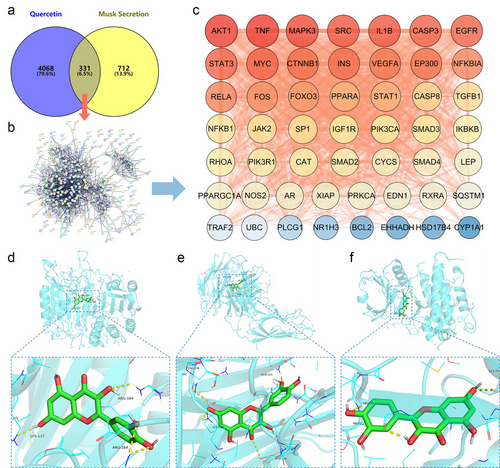
In order to more accurately evaluate the ability of quercetin to combine with key targets, we also docked the key targets with quercetin (Figs. 1d–f). The docking model showed that quercetin had good spontaneous binding activity and binding site to the target. The average binding energy of quercetin key target is −7.8 kcal mol−1 (Table S3, Supporting Information). It is generally believed that a binding energy less than 0 kcal mol−1 indicates that the component and the target can bind spontaneously, less than −4.25 kcal mol−1 indicates better docking affinity, and less than −7 kcal mol−1 indicates stronger docking affinity (Gaillard 2018). Quercetin docked well with all the key targets, indicating that quercetin may have an effect on musk secretion of FMD through these targets.
GO and KEGG pathway enrichment analysis
In order to reveal the role of quercetin in affecting musk secretion of FMD, we analyzed the enrichment of potential targets by KEGG pathway and GO. A total of 140 signal pathways were obtained by KEGG pathway enrichment analysis (P < 0.05, Table S4, Supporting Information). The first eight pathways sorted by P-value are shown in Fig. 2a, mainly including calcium signaling pathway, hepatitis B, lipid and atherosclerosis, apoptosis, necroptosis, EGFR tyrosine kinase inhibitor resistance, TGF-beta signaling pathway, and so on. A complete of 3168 biofunctional entries were obtained from GO enrichment analysis (P < 0.05, Table S5,Supporting Information), and the first 8 entries are shown in Fig. 2b. Among them, 2830 were related to biological processes (BPs), 96 to cellular components (CCs), and 242 to molecular functions (MFs).
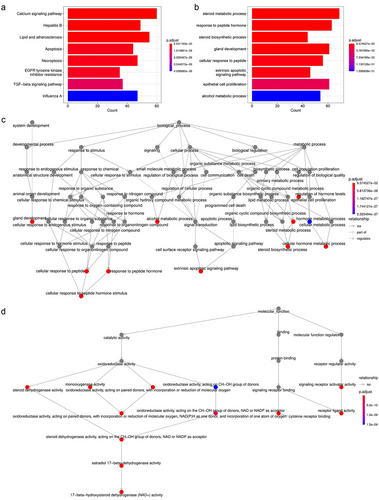
The BP and MF items are further analyzed, and the classification hierarchy relationship between the items is shown with a directed acyclic graph (Fig. 2c,d). BP locates to gland development, cellular response to peptide hormone stimulus, extrinsic apoptotic signaling pathway, steroid biosynthetic process, cellular hormone metabolic process, etc. MF highlights the molecular function of 17-beta-hydroxysteroid dehydrogenase (NAD+) activity. It is suggested that quercetin may affect musk secretion of FMD mainly through these biological processes and molecular functions.
Quercetin affects the hormone levels of FMD
Musk is a special secretion closely related to sexual behavior, and sex hormones play an important role in the formation of musk (Fan et al. 2018; Zhou et al. 2019). According to the reported results and the predicted results of network pharmacology, the hormone level of FMD was detected in this experiment (Fig. 3).

With the increase of dietary quercetin, the contents of T, 17-ketosteroid (17-KS), and cortisol (Cor) increased at first and then decreased; the contents of LHRH and LH increased gradually; and the content of estradiol (E2) decreased at first and then increased. The content of T in male FMD was positively correlated with the secretion of musk (Yang et al. 2021). 17-KS is an important metabolite of T, which is of great value in evaluating the function of adrenal gland secreting androgen, and it has been proved that its content increases significantly in the early stage of musk secretion (Fan et al. 2018). In this experiment, the concentration of 17-KS was the same as that of T, which was higher in Q groups than that in C group. Therefore, the addition of quercetin to diet may promote the synthesis and secretion of musk.
The content of Cor is an important index to measure the stress degree of animals (Li et al. 2007). In this experiment, the concentration of Cor in Q2 was significantly lower than that in C (P < 0.05). This shows that quercetin can alleviate the stress injury of FMD in the period of incense secretion to some extent.
Quercetin changes the structure and function of musk microorganisms
The strong smell of musk may be produced by microbial fermentation, and the composition of musk and its changes in musk glands may also lead to changes in the composition of microorganisms (Hawkins 1950; Li et al. 2018). At the same time, the existence and succession of bacterial community are also considered to be important factors leading to the change of musk composition (Li et al. 2016). 16s ribosomal DNA gene sequence analysis showed that quercetin treatment significantly changed the bacterial richness (ASVS), α-diversity, and β-diversity.
ACE index is used to measure species abundance, Shannon and Simpson index are used to reflect species diversity, and PD whole tree is used to reflect community diversity (Table 1). Anosim analysis (Fig. 4a) showed that the difference of musk microflora structure between the Q groups and the C group was greater than that within the group (R-value < 0, P < 0 05). Collaborative analysis (PCoA) and non-metric multidimensional scaling map (NMDS) showed that the microflora structure of C group was significantly different from that of Q groups (Fig. 4b,c). The microflora structure of Q groups and C group showed independent distribution. It is suggested that quercetin can affect the flora structure of musk microorganisms.
| Groups | ||||
|---|---|---|---|---|
| Items | C | Q1 | Q2 | Q3 |
| ACE | 156.8 ± 3.72b | 360.8 ± 5.14a | 152.85 ± 3.3b | 42.8 ± 1.69c |
| Simpson | 0.9279 ± 0.0003b | 0.985 ± 0.0002a | 0.5393 ± 0.0042c | 0.5969 ± 0.0078d |
| Shannon | 4.78 ± 0.01b | 7.35 ± 0.02a | 2.49 ± 0.03c | 2.24 ± 0.02d |
| PD whole tree | 12.95 ± 0.33c | 31.79 ± 0.28a | 14.76 ± 0.38b | 4.6 ± 0.23d |
- In the same line, the values of different letters indicate significant differences (P < 0.05), while the values of no letters or the same letters indicate that the differences are not significant (P < 0.05). The tables below are marked in the same way.
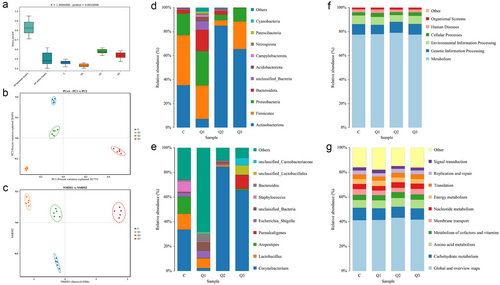
The community structure of musk microorganisms was further analyzed at the phylum and genus level (Fig. 4d,e). At the phylum level, the dominant flora of each group were Actinobacteriota, Firmicutes, Proteobacteria, and Bacteroidetes, which was consistent with the previous studies (Li et al. 2018).
It is reported that the better the quality of musk, the higher the proportion of Actinobacteriota and Firmicutes, and the lower the proportion of Proteobacteria (Li et al. 2016). Actinobacteria have a wide range of secondary metabolism, including many antibacterial, anticancer, antiparasitic, and antifungal compounds. At present, about 2/3 of the naturally derived antibiotics used in clinic are produced by Actinobacteria (Barka et al. 2016). This may be one of the reasons why musk has antibacterial activity. The proportion of Actinobacteriota in Q2 Group (84.9%) was higher than that in other groups, even more than twice that of C Group (35.3%), and the proportion of Proteobacteria was the lowest. The results showed that the quality of musk could be improved by adding quercetin at 800 mg kg−1 to the basal diet.
At the genus level, the dominant flora of each group were Corynebacterium, Lactobacillus, Atopostipes, Proteus, and Bacteroides. The relative abundance of Corynebacterium Q2 group is 84.6%, which is absolutely dominant. Corynebacterium produces not only amino acids such as glutamic acid and lysine, but also nucleotides and vitamins (Vertes et al. 2012). At the same time, Corynebacterium has strong catalytic activity and can carry out high-density fermentation (Vertes et al. 2012). This means that Corynebacterium may have made an outstanding contribution to providing the substances needed to produce musk and promoting musk ripening.
The species composition information obtained by comparing 16S-rRNA sequencing data by PICRUSt software was used to infer the composition of functional genes in FMD feces, including the first-level functional pathway (Fig. 4f) and the second-level functional pathway (Fig. 4g). With the increase of dietary flavonoids, the relative abundance of carbohydrate metabolic pathway decreased and the relative abundance of amino acid metabolic pathway increased; the relative abundance of cofactor and vitamin metabolism, nucleotide metabolism, and replication and repair pathway decreased at first and then increased. Therefore, the addition of quercetin to the diet can change the flora structure of musk and may provide the components needed for musk ripening.
Quercetin alters the overall structure of the intestinal microorganisms
Intestinal microbiome plays an important role in the digestion and absorption of food and the maintenance of animal health (Smith et al. 2013). At the same time, changes in dietary choices are also thought to quickly affect the composition of intestinal microflora (Wang et al. 2019).
Sequence analysis of 16s ribosomal DNA gene showed that quercetin treatment significantly increased α-diversity (Table 2) in Q1 and Q2. Anosim analysis (Fig. 5a) showed that the difference of intestinal microflora structure between the Q groups and the C group was greater than that within the group (R-value < 0.05, P < 0. 05). PCoA and NMDS analysis (Fig. 5b,c) showed that Q1 and Q2 had high similarity, but the microbial flora structure of C group was significantly different from that of Q groups. These results suggest that the addition of flavonoids can affect the structure of intestinal microflora of FMD.
| Groups | ||||
|---|---|---|---|---|
| Items | C | Q1 | Q2 | Q3 |
| ACE | 409.88 ± 5.12a | 383.86 ± 19.87ab | 414.42 ± 6.15a | 346.45 ± 5.58b |
| Simpson | 0.9893 ± 0.0004a | 0.9871 ± 0.0025a | 0.9923 ± 0.0004a | 0.9758 ± 0.005b |
| Shannon | 7.67 ± 0.02a | 7.49 ± 0.16a | 7.82 ± 0.04a | 6.97 ± 0.13b |
| PD whole tree | 21.46 ± 0.17a | 22.36 ± 0.97a | 23.14 ± 0.36a | 19.66 ± 0.22b |
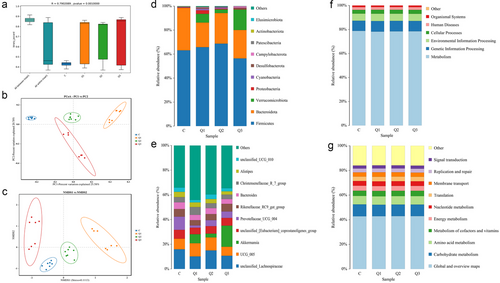
At the phylum level (Fig. 5d), the dominant flora in all groups were Firmicutes and Bacteroidetes. However, quercetin increases the relative abundance of Verrucomicrobia, and it is mainly Akkermansia that makes this contribution (Fig. 5e). Verrucomicrobia exist in the inner layer of intestinal mucosa and their abundance is closely related to intestinal health. Akkermansia is one of the most studied bacteria in Verrucomicrobia, which can promote the growth and maintenance of intestinal mucus layer, enhance intestinal barrier function, reduce the growth of harmful bacteria, and reduce the level of intestinal endotoxin, so as to protect intestinal health (Cani et al. 2022; Liu et al. 2022).
However, there was no significant change between C group and Q groups in the main metabolic pathway of intestinal microbes KEGG (Fig. 5f,g). This could mean that quercetin benefits gut health without altering the main metabolic pathways of gut microbes.
Quercetin increases the active components in musk
The moisture content of the musk samples was around 50%, and this matched the results of previous studies (Fan et al. 2018). There was no significant difference in water content among groups C, Q1, and Q2, but the average water content in Q3 group was significantly higher than that in Q2 (P < 0.05, Fig. 6a). Muscone is considered to be the most important ingredient in musk and is responsible for the main biological activity (Song et al. 2017; Du et al. 2018). According to Chinese Pharmacopoeia (2015), the qualification standard for musk is that the concentration of muscone is more than 2.0%. All the samples in this test are up to the standard. The muscone content of Q2 group was 3.99%, which was significantly higher than that of C group (Fig. 6b). Except that the content of cyclopentadecanone in musk samples in Q3 group was significantly lower than that in groups Q1, Q2, and C, the contents of other major components in musk, such as cholesterol, dehydroepiandrosterone, and androstane-3,17-dione, did not change significantly among the groups (P > 0.05, Fig. 6c–f).
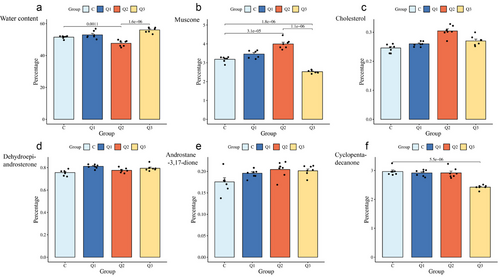
The detection results of the main components of musk showed that the addition of quercetin could increase the content of muscone without changing the structure of other components of musk. That is, quercetin can promote the secretion of muscone, the most important active ingredient, and improve the medicinal value of musk to a certain extent.
Correlation among musk composition, musk microorganisms, intestinal microorganisms, and hormone levels in FMD
Sex hormones have been thought to play a role in determining the composition of musk, but the secretion and maturation of musk are controlled by many factors. We speculate that there may be interactions among musk components, microorganisms, and hormones (Fig. 7). Correlation analysis showed that the content of muscone was positively correlated with the level of T and negatively correlated with the level of E2. This is consistent with the results of previous studies, indicating that an appropriate amount of androgen supplement is an important way to maintain the secretion of FDM. Microbiologically, the abundance of Patescibacteria and Cyanobacteria in both musk and gut was positively correlated with muscone content and played an important role in the overall correlation network.
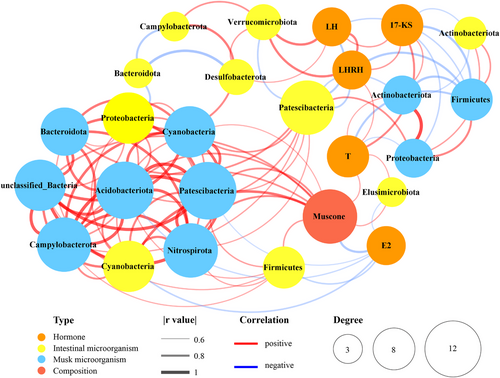
Patescibacteria is considered to be a nutrient-deficient microorganism, which requires a bacterial host to grow, and can regulate the microbial environment by affecting the growth of other bacteria, a property that may help to stabilize the microflora (Naud et al. 2022). An important role of Patescibacteria in both musk and gut may be the reason for this. In addition, Patescibacteria can promote the biofilm formation of its host and has been shown to promote the growth of bacteria involved in oral biofilm formation under healthy conditions (Naud et al. 2022). It is suggested that Patescibacteria may be involved in the process of rupture and repair of a large number of incense gland cells (GCs) during musk secretion.
Cyanobacterium can produce a secondary metabolite called phycocyanobilin, which has anti-tumor, antioxidant, anti-inflammatory and other functions (Li 2022). It is a potential natural anti-inflammatory agent and has extensive medicinal value. However, it has not been reported whether phycocyanobilin is involved in the formation of musk, which may be a direction worth exploring.
Furthermore, Acidobacteriota also plays a key role in the correlation network. The abundance of Acidobacteriota was positively correlated not only with the content of muscone, but also with other microorganisms which were positively correlated with the content of muscone. Such as the abundance of Acidobacteriota was also positively correlated with the abundance of cyanobacteria and Firmicutes in the intestine, as well as the abundance of Campylobacterota, Cyanobacteria, Nitrospirota and Patescibacteria in musk. This may be related to the fact that the Acidobacteriota genome contains genes that regulate the synthesis of various secondary metabolites and other natural compounds, such as siderophores, antifungal drugs, and antibiotics (Kalam et al. 2020). In addition, exopolysaccharide secreted by Acidobacteriota contributes to the formation of soil aggregates and can be used as a natural and environmentally friendly binder in the biological fertilizer industry (Kielak et al. 2017). Perhaps, exopolysaccharide also helps musk precursors form aggregates and eventually become mature solid musk.
The correlation network confirmed our suspicion that there is a correlation among musk components, hormones, and microorganisms, an indication that the secretion and maturation of musk may be governed by a complex interaction between the three.
DISCUSSION
Although captive breeding is an effective way to help endangered species restore their populations, potential stressors caused by the captive environment can lead to animal health problems (He et al. 2014). Chronic stress is a common threat to the health of captive animals, which can cause physiological disorders (Mcewen 2004). It has been found that the concentration of Cor increases during the musk secretion period of FMD, and there is no significant correlation between Cor level and musk composition (He et al. 2014). This shows that FMD is prone to high stress reaction during the musk secretion period. In this experiment, the addition of 800 mg kg−1 quercetin to the basal diet decreased the level of Cor in FMD, indicating that quercetin reduced the stress response of FMD to some extent, and feeding does not cause mechanical damage to the musk deer as hormone injections do.
Feeding quercetin to FMD also affected the structure and function of musk microorganisms and intestinal microorganisms, and we also proved that there is a correlation among musk microorganisms, intestinal microorganisms, hormones, and musk components. It has been found that musk gland epithelial cells cultured in vitro can produce lipid droplets, but muscone is not found in the secretion (Chen et al. 2018). Therefore, we speculate that microorganisms must be involved in the formation of muscone. Combined with the prediction results of network pharmacology and experimental results, we finally summarized a possible mechanism of quercetin promoting musk secretion of FMD (Fig. 8).
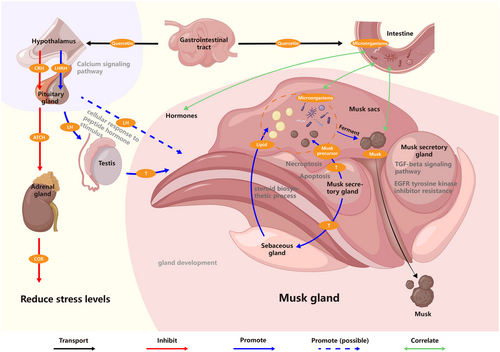
According to the prediction of network pharmacology, the effect of quercetin on musk secretion of FMD mainly reflects hormone response, gland development, and anabolism of steroids. Nineteen steroids have been detected in musk, including androgen, progesterone, estrogen, and sterol (He et al. 2018), suggesting that steroids, especially sex hormones, play an important role in the formation of musk. Gonadotropin cells are basophils of the anterior pituitary, which can secrete gonadotropins such as FSH and LH due to the increase of intracellular calcium concentration (Jenks 2009; Stojilkovic 2012). Quercetin has been shown to increase the Ca2+ influx of pituitary GH3 cells, prolong the duration of Ca2+-dependent action potentials, and promote the increase of spontaneous action potential discharges of GH3 cells (Wu et al. 2003). In this experiment, quercetin increased the levels of sex hormones such as T, LHRH and LH of FMD. Therefore, quercetin may promote the secretion of LH and FSH through the calcium signaling pathway predicted above and then increase the production of T and 17-KS.
Another important physiological function of androgen is to promote the growth and development of exocrine glands. Studies have shown that FMD produce more androgen receptor (AR) and androgens to regulate the development of musk glands and musk production during the breeding season (Lu et al. 2014; Zhang et al. 2017). The sebum secreted by the sebaceous gland in the musk gland enters the musk gland cavity and mixes with the immature musk to form the mature musk (Chen et al. 2018). After androgen binds to sebaceous gland AR, it may stimulate sebaceous gland cell proliferation and differentiation and sebum secretion by regulating genes related to cell growth factors and lipid metabolic enzymes (Pochi et al. 1979; Rosignoli et al. 2003). The key genes for steroid synthesis have also been found to be expressed in musk glands, suggesting that musk glands of FMD have the potential to synthesize steroids locally, in which undifferentiated round nucleus GCs in musk gland ducts may be involved in androgen synthesis (Yang et al. 2021). We speculate that the production of steroids produced by musk glands is also regulated by LHRH and LH. LHRH and LH are polypeptide hormones, while T and 17-KS are steroid hormones, which correspond to the biological processes such as cellular response to peptide hormone stimulus and steroid biosynthetic process, which are significantly enriched in GO analysis.
Musk gland is a kind of exocrine gland, which grows and degenerates seasonally and periodically. Its volume reaches its maximum at the peak of musk production and gradually shrinks in the nonsecreting period (Fan et al. 2018). The glandular cells of musk glands secrete immature musk by apocrine secretion, and a large number of glandular cells are constantly ruptured and repaired during the secretory stage of musk (Chen et al. 2018; Yang et al. 2021). Muskrat is a commonly used model to study the mechanism of musk secretion in FMD. It has been found that the expression of apoptosis key gene Caspase-3 during musk secretion is higher than that in musk gland atrophy, suggesting that apoptosis plays an important role in musk secretion (Guang 2020). Both necroptosis pathway gene and Caspase-3 gene are highly expressed in muskrat musk gland atrophy, suggesting that programmed necrosis and apoptosis promote the atrophy of muskrat musk gland. Quercetin has a bidirectional effect on apoptosis. It inhibits apoptosis of podocytes by inhibiting the EGFR signaling pathway to cleave Caspase-3 that also induces apoptosis in breast cancer cells (Lee et al. 2015; Balakrishnan et al. 2017; Liu et al. 2021). In addition, TGF-β signal pathway also plays a role in musk gland degeneration. The genes involved in TGF-β signal pathway are significantly more expressed in nonsecretory season than in secretory season (Li et al. 2017), while quercetin can inhibit the expression of TGF-β signaling pathway (Wang et al. 2021). According to the experimental results of increased muscone, it is speculated that quercetin may play an active role in maintaining the normal function of musk glands, but further exploration is needed.
CONCLUSIONS
Quercetin could change the levels of T, LHRH, LH, and E2, and regulate the structure of intestinal microorganisms and musk microorganisms of FMD. In each treatment, adding 800 mg kg−1 of quercetin to the diet can significantly increase the content of muscone in musk, and the correlation network analysis shows that the production of musk may be regulated by hormones, intestinal microorganisms, and musk microorganisms at the same time. In addition, quercetin decreased the high level of Cor during musk secretion, which may relieve the stress on FMD in this process.
ACKNOWLEDGMENTS
The present study was supported by the Forestry Science and Technology Innovation Project of Shaanxi Province (grant number SXLK2021-0219; SXLK2020-0207). The authors would like to thank the Economic Animal Laboratory of the College of Animal Science and Technology, Northwest A & F University for providing experimental equipment for this study, and the economic animal health breeding team for providing technical guidance.



